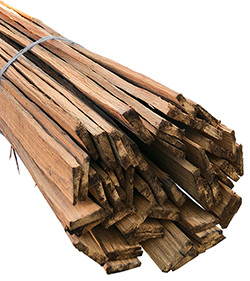
We make every effort to provide an accurate representation but images and colours may vary from the product.
Riven Chestnut Laths (4ft Lengths, Bundle of 50)
- Hand Split, Strong Key
- Highly Durable Chestnut
- Soaks Easier than Oak
- Covers 2.25m² (approx.)
Product Details
Riven oak laths are supplied in bundles containing 4' (1.22m) lengths. They are used to build traditional lath and plaster walls, they can also be used to replace laths in damaged areas of an old wall.
Riven Laths
Timber is naturally hand split into randomly shaped laths and cut roughly to length. This produces a coarse, uneven surface providing the most effective key for a lime plaster.
However, this means the laths are more expensive and fixing is more difficult and time consuming. If cost, time or simplicity are factors, consider sawn oak or sawn larch laths.
Riven laths do not offer additional durabilty. Although they are split naturally along the grain, riven laths are still cut to length. This causes short-grain areas where moisture can penetrate more readily, just as it can with sawn laths.
Lath and Plaster Walls
Timber laths are an ideal background for lime plaster, they provide a good key and form a gauge that keeps the plaster relatively even. They also help prevent shrinkage cracking when applied correctly.
Fixing
The laths are fixed horizontally to the wall or studs, typically with 10mm spacing between them. The gaps between must not exceed twice the largest particle size in the plaster base coat.
Traditionally fixed using stainless steel ring shank nails, these remain the best method for fixing laths manually. These stainless steel nails will resist chemical attack from timber containing resin (larch) and tannin (oak, chestnut) and from the lime binder in the plaster.
We recommend 40mm - 50mm lengths which extend sufficiently beyond the lath into the stud, the ring shank ensuring a firm anchor. This provides the secure and permanent grip required for a traditional 3 coat lime plater system (typically weighs 48kg per m² or more).
Preparation (Important)
Timber laths must be completely saturated when fixed, they will shrink and pull tight as they dry out. This requires the lengths are fully immersed in water for at least 7 days (although longer is better) up until the point of fixing.
The laths must be soaked through again (typically with a nap sack sprayer) 2 hours before plastering work proceeds. Plastering onto wet laths helps prevent cracking, otherwise, dry timber would suck the moisture rapidly from the lime plaster as it is applied.
As the laths were saturated initially when fixed, they simply expand back to their original position rather than buckling and failing as is common when laths are fixed dry.
Sweet Chestnut
Sweet Chestnut is ideal for traditional riving as it's naturally inclined to split down the grain. It is strong and durable like oak although less dense, this makes chestnut much easier to soak and well suited for traditional laths.
Like oak, it contains tannic acid a natural tannin which contributes to its inherent durability. However, the tannin can leach and produce stains, similar to tea stains, on the plaster surface.
This is possible where timber has a high moisture content which is absolutely necessary to fix the laths and apply the lime plaster successfully.
Should this occur, sugar soap or oxalic acid can be used to effectively treat stains on internal walls. UV light will also effectively deal with any stains occurring to external walls given sufficient time.
Coppiced
The products are sourced from coppiced woodlands. Coppicing is a way of harvesting chestnut round wood without completely felling the tree.
It naturally regrows when cut so the chestnut can be re-harvested every 4 years or so as the round wood gets to a suitable diameter for its purpose.
Coppicing is a low intensity way of working carrying a very low carbon footprint, machines are rarely required so ground conditions remain undisturbed.
- Quantity
- Bundle of 50 (200ft)
- Type
- Sweet Chestnut
- Format
- Riven
- Section
- 1¼" x ¼" (32mm x 6mm)
- Weight
- 15.0
- Length
- 4ft Lengths
- Total Length
- 200ft (60m) (approx.)
- Coverage
- 2.25m² (approx.)
- Density
- 560 kg/m³ (approx.) †
- Advisory
- This material contains natural tannins which could lead to staining §
† Density of timber may vary up to 20% ± depending on moisture content and other factors.
§ Tannic acid, also known as Quercittanic acid, is a tannin that occurs naturally in chestnut and contributes to its inherent durability. However, where timber has a high moisture content, it is possible that the tannin can leach and produce stains (resembling a tea stain) on the surface of the plaster. This is a natural phenonmenon, outside our control, we cannot accept any repsonsibility for it. Sugar soap or oxalic acid can be used to effectively treat stains internally, UV light will also effectively deal with any stains occurring to external plaster or render given sufficient time.
